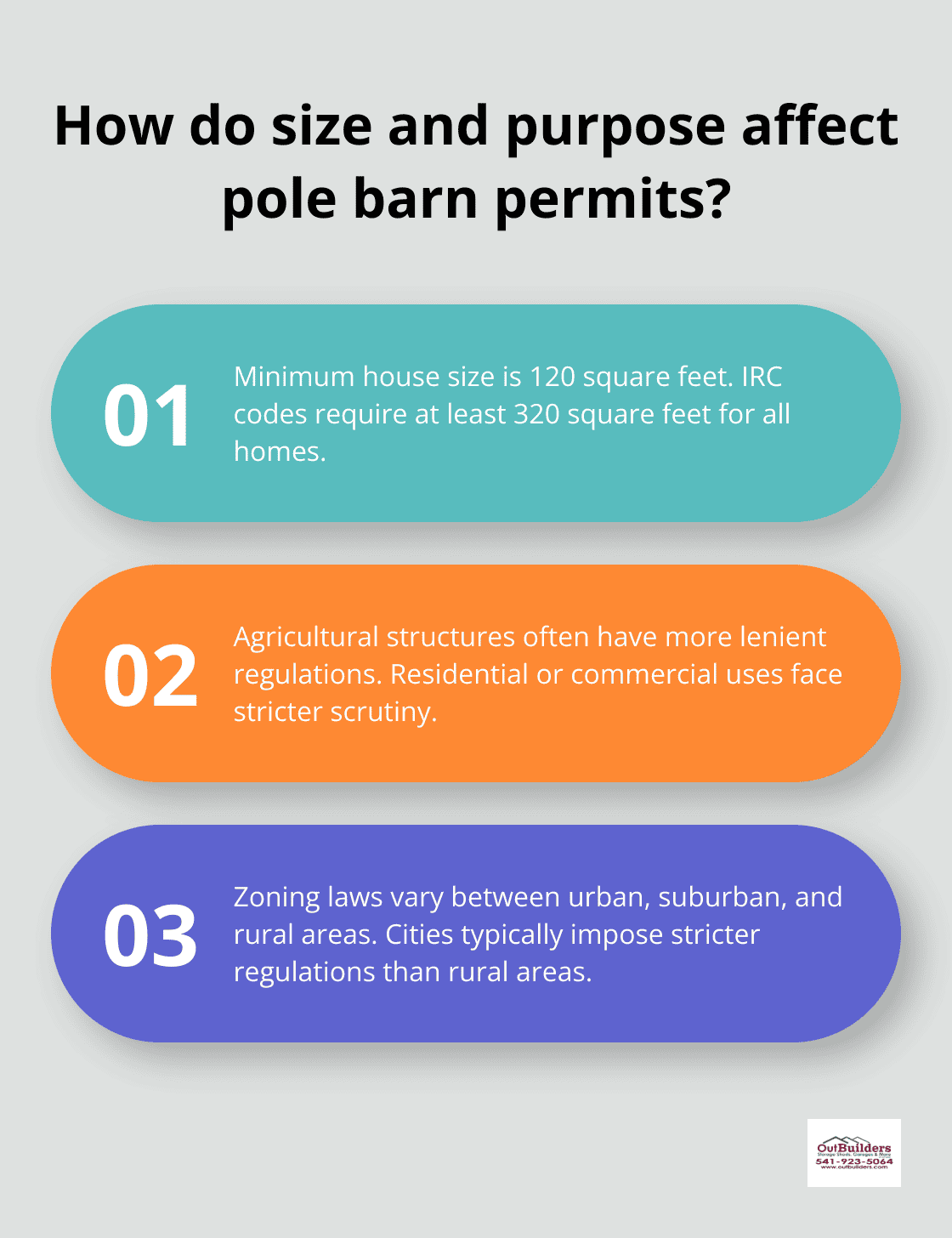At Outbuilders, we often get asked: “Do pole barns need permits?” It’s a common question for those considering these versatile structures.
Pole barns, known for their simplicity and cost-effectiveness, have become increasingly popular for various uses. However, navigating the permit requirements can be tricky, as they vary depending on several factors.
What Are Pole Barns?
The Essence of Pole Barn Construction
Pole barns represent a simple yet versatile building solution that has gained significant traction in recent years. These structures, defined by their post-frame construction, offer a cost-effective option for various storage and workspace needs.

The foundation of pole barn construction lies in large poles or posts, which are either buried in the ground or anchored to a concrete base. These posts act as the primary support for the roof and walls. Unlike traditional buildings, pole barns don’t require a continuous foundation, which cuts down on construction costs and time significantly.
The walls of a pole barn typically consist of horizontal girts attached to the vertical posts, which support the exterior siding. Roof trusses span between the poles, creating a robust framework for the roof covering. This straightforward design allows for spacious, open interiors without the need for load-bearing walls.
Adaptability in Design and Function
One of the standout features of pole barns is their adaptability. While they’re commonly used for agricultural purposes (such as housing livestock or storing equipment), their applications extend far beyond the farm. We’ve observed pole barns transformed into workshops, garages, retail spaces, and even residential homes.
The flexibility in design allows for easy customization. Large door openings can accommodate machinery or vehicles, while windows and insulation can be added for comfort in various climates. Some pole barns even incorporate living quarters or office spaces, blending functionality with comfort.
Economic Advantages and Space Efficiency
Pole barns are renowned for their economic benefits. The streamlined construction process requires less labor and materials compared to traditional buildings. This translates to lower overall costs and faster completion times.
Furthermore, the open design of pole barns allows for efficient use of interior space. The absence of internal support columns means you can maximize the usable area, making them ideal for storage or workspace applications where maneuverability is key.
Considerations for Construction
While pole barns offer numerous benefits, it’s important to note that their construction still requires careful planning and adherence to local building codes. Understanding the factors that influence permit requirements (which we’ll explore in the next section) is essential for a successful pole barn project.
At Outbuilders, we specialize in creating high-quality, customized storage solutions, including pole barns. Our expert team ensures exceptional craftsmanship using top-grade materials, with construction done on-site for personalized designs. We offer various customization options like insulation, windows, and shelving to meet your specific needs.
As we move forward, let’s examine the factors that determine whether your pole barn project will require a building permit.
What Determines Permit Requirements?
Size and Scale
The size of your pole barn often dictates permit requirements. Many jurisdictions set size thresholds that determine the need for a permit. For example, the minimum square footage for a house is 120 square feet, with the IRC codes requiring a minimum of 320 square feet for all homes. Height restrictions also play a significant role, with taller structures typically facing stricter regulations.
Intended Purpose
The purpose of your pole barn significantly impacts permit requirements. Agricultural structures often enjoy more lenient regulations. A pole barn used solely for storing farm equipment might be exempt from certain building codes. However, residential or commercial uses typically face more rigorous scrutiny and permit processes.
Location and Zoning
Where you plan to build your pole barn is a critical factor. Zoning laws vary widely between urban, suburban, and rural areas. Cities often impose stricter regulations and may require adherence to specific aesthetic guidelines. Rural areas typically have more relaxed rules, but assumptions can lead to problems. Always check with your local planning department for specific zoning requirements.

Setback requirements (the minimum distance your structure must be from property lines) can also impact your pole barn’s location and design. These can range from a few feet to several dozen, depending on your area.
Local Building Codes
Local building codes serve as rulebooks for construction projects, including pole barns. These codes ensure structures meet safety and quality standards. They cover aspects like structural integrity, fire safety, and energy efficiency.
Some jurisdictions have adopted specific post-frame building codes, while others apply general construction standards to pole barns. It’s essential to familiarize yourself with these local ordinances before starting your project.
Environmental Considerations
Environmental factors can also influence permit requirements. Areas prone to high winds, heavy snowfall, or seismic activity may have additional structural requirements. Flood zones often have specific regulations to protect buildings and occupants. These environmental considerations can affect the design, materials, and overall cost of your pole barn project.
Understanding these factors is just the first step in the permit process. The next chapter will guide you through the actual permit application process, helping you navigate the paperwork and procedures necessary to get your pole barn project off the ground.
Navigating the Permit Process
Initial Steps: Determining Permit Necessity
The first step involves contacting your local building department. Every jurisdiction has unique requirements, so it’s essential to obtain information directly from the source. Some areas offer online resources or phone consultations to help you determine if your pole barn project needs a permit.

Most pole barns over 200 square feet typically require a permit. However, agricultural structures in rural areas often have different rules. For example, in Deschutes County, Oregon, only buildings in areas zoned EFU, F1, F2 or MUA10 AND receiving tax deferral for farmland or forestland will be considered for an exemption.
Required Documentation
Once you’ve established that a permit is necessary, you’ll need to prepare a comprehensive application package. This usually includes:
- A detailed site plan (showing the proposed location of your pole barn, property lines, and existing structures)
- Engineered building plans (including foundation details, framing plans, and cross-sections)
- Structural calculations (especially for larger or more complex designs)
- Proof of property ownership or written permission from the property owner
Some jurisdictions may require additional documents like a soils report or environmental impact assessment. It’s best to ask for a complete checklist from your local building department to ensure you have everything needed.
Inspection Requirements
Building inspections form a critical part of the permit process. Typically, you’ll need inspections at various stages of construction:
- Foundation inspection (before pouring concrete)
- Framing inspection (once the structure is up)
- Final inspection (upon completion of the project)
Each inspection ensures that your pole barn meets safety standards and adheres to the approved plans. Failed inspections can lead to costly delays, so it’s important to follow the approved plans closely.
Costs and Timeline Considerations
Permit fees vary widely depending on your location and the size of your project. Fees can range from a few hundred dollars to several thousand for larger, more complex structures. Some jurisdictions calculate fees based on the project’s value, while others use a flat rate or square footage basis.
The permit review process can take up to 6-12 months or longer to approve your building plan, so it’s important to be patient. There is a lot to be reviewed.
Obtaining a permit might seem like an extra hurdle, but it’s an investment in the safety and longevity of your pole barn. Try to view it as a necessary step in ensuring your structure meets or exceeds local building standards. Navigating local regulations can be complex, but it’s crucial for the success of your project.
Final Thoughts
The question “Do pole barns need permits?” has no universal answer. It depends on factors like location, size, and intended use. Complying with local regulations ensures safety, quality, and legality of your structure. Proper permits and inspections can identify potential issues early, saving time and money in the long run.

A properly permitted pole barn maintains its value and becomes a significant asset. It provides peace of mind, knowing your structure meets all necessary safety and building code requirements. We recommend starting with thorough research into your local building codes and zoning laws.
Consider working with experienced professionals who understand pole barn construction and local regulations. At Outbuilders, we create high-quality, customized storage solutions (including pole barns). Our team can guide you through the permit process, ensuring your project meets all necessary requirements.







Recent Comments